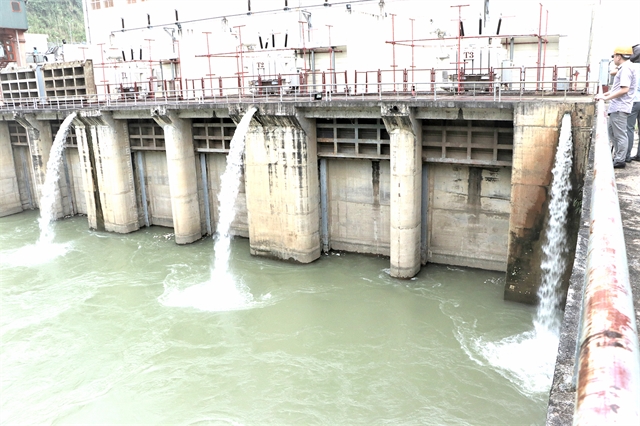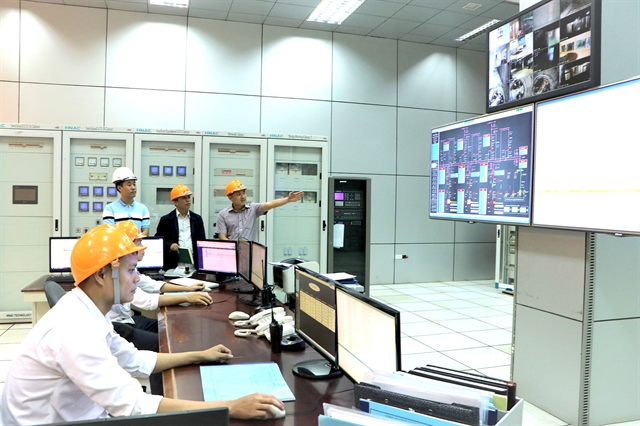 Society
Society

Data from the province showed that revenue from hydro-power projects accounts for nearly 70 per cent of the province’s total budget revenue for the two years of 2022 and 2023, about VNĐ1.6 trillion (US$65.3 million). The province also collected more than VNĐ500 billion ($20.3 million) from fees of forest environmental services from the projects each year.

|
| Nậm Na Hydro-power Plant in the northern mountainous province of Lai Châu.—VNA/VNS Photo Việt Hoàng |
LAI CHÂU — Hydro-power projects have made remarkable contribution to the development of the northern mountainous province of Lai Châu over the past time, however, the draft of the schedule to implement the National Power Development Plan VIII is believed to slow down the development of hydro-power projects in the province in the future.
Therefore, the province urgently needs more attention and direction from relevant ministries and sectors so the hydroelectric field in the province can achieve sustainable development.
Data from the province showed that revenue from hydro-power projects accounts for nearly 70 per cent of the province’s total budget revenue for the two years of 2022 and 2023, about VNĐ1.6 trillion (US$65.3 million). The province also collected more than VNĐ500 billion ($20.3 million) from fees of forest environmental services from the projects each year.
Besides, the hydro-power projects have also provided jobs for thousands of local workers, the Nhân dân (People) online newspaper reported.
Lầu A Hồ, of Sang Phàng Cao Village, Khun Há Commune, Tam Đường District, a worker of Nậm Đích 1 Hydro-power Plant under the Khun Há Hydro-power Plant Joint Stock Company, said he worked for the plant for four years with the salary of VNĐ 8 million ($328) per month, excluding allowances and bonuses.
“Thanks to the income, I could afford the daily expenses for my family,” he said.
At first, Hồ only had a certificate of elementary electricity. In addition to working for some construction projects in the district, he did electrical repairs for local people in the village, but his income was unstable.
So, when the company invested in building the hydro-power plant, they recruited him and sent him to study more so that he was qualified to be in charge of the electric operation at the plant.
Hồ realised that the job brought him a stable income each month, so he told his eldest son to follow his father's profession.
Now, his son also works as an electric operating engineer at a local hydro-power plant with a stable income.
Hồ and his son are among nearly 1,000 local ethnic people, who are working as operators for 49 hydroelectric plants with an income of VNĐ 8-12 million ($328-491) per month in the province.
As calculated, when all 160 small-and-medium hydro-power plants are put into operation in the province, the number of employees to be recruited for electricity operating at the plants will reach about 3,000.
In addition, the construction of the hydro-power plants is expected to create seasonal jobs for tens of thousands of manual workers.
Each year, the revenue from the forest environment services is about VNĐ500 billion ($20.5 million). More than 84,000 ethnic minority households benefited from the service’s revenue. The average payment is nearly VNĐ6 million ($244) per household each year.
With the money from the forest environmental services, more than 450,000 ha of local forests in the province are regularly cared for and protected, increasing the level of forest coverage from 41.6 per cent in 2011 to more than 52 per cent so far.
Many households receive an amount of over VNĐ40 million ($1,640) each year from the services’ revenue in the communes of Mù Cả and Tà Tổng, in Mường Tè District.
Two households of Pờ Lò Xó and Lý Lòng Cà have escaped poverty by buying more cows and goats, or raising more bees for honey, from the money they received from the services.
Phạm Ngọc Nghĩa, deputy director of the provincial Tax Department, said that units operating hydroelectric projects in the province always paid taxes on time.
For a mountainous province like Lai Châu, if there were no hydroelectric plants, the annual budget revenue would be very low, he said.
Besides tax revenue from the hydro-power plants, there is only land tax and some other very small revenues, as the province had no industrial clusters or zones.
Therefore, the tax revenue from the hydroelectric plants accounted for nearly 70 per cent of local budget revenue each year, he added.
It was expected that when all hydroelectric projects were put into operation, they would annually contribute about VNĐ3.31 trillion ($135.6 million) to the province’s tax revenue.
Small hydro-power projects would account for about VNĐ1.71 trillion ($70 million), equivalent to 51.87 per cent of total tax revenue from hydro-power plants.
Sustainable development required

|
| Electric engineers at an operating room in Nậm Na Hydro-power Plant in the northern mountainous province of Lai Châu. — VNA/VNS Photo Việt Hoàng |
According to the province's planning for 2021-30, and vision towards 2050, approved by the Prime Minister in Decision 1585/QĐ-TTg on December 7, 2023, the province would have 160 hydro-power projects with a total capacity of over 4,271 MW and an average annual electricity output of 15.6 million kWh.
The provincial People's Committee had approved investment policies for 122 hydroelectric projects with a total capacity of over 3,866 MW, an average annual electricity output of more than 14.1 million kWh, with a total investment of more than VNĐ120.4 trillion ($4.9 billion).
As many as 49 projects have been put into operation to generate electricity with a total capacity of over 2,895 MW, with an average annual electricity output of over 10,859 million kWh.
The province has not had to resettle any households to serve the establishment and operation of the hydro-power plants so far.
Investors of the hydro-power plants have paid attention to the daily lives of local people in the province, such as providing electricity to serve daily life and production to people in areas that do not have access to the national power grid in Nhóm Pố Village, Tá Bạ Commune, Mường Tè District and Nậm Sập Village, Pá Đởn Village, Nậm Hàng Commune in Nậm Nhùn District; supporting some villages to build cultural houses and inter-village roads.
Lê Văn Lương, Chairman of the provincial People's Committee, said the development orientation for the energy field in the province always complied with the policies of the State and the provincial Party Committee.
The hydro-power projects in the province were contributing a part of their electricity output to the national power grid, promoting the province's socio-economic development, improving the local infrastructure; creating more jobs and stabilising people's lives; reducing floods for downstream areas in the rainy season, regulating water for daily life and production in the dry season, forming aquaculture lakes, and developing tourism, he said.
However, according to the draft of the schedule to implement the National Power Development Plan VIII, attached to Report 7146/TTr-BCT on October 12, 2023 of the Ministry of Industry and Trade, by 2030, the province will be allocated a capacity of only 1,529 MW for small hydroelectric projects; 10MW for biomass electricity; while other power sources such as onshore wind power, solar power, and electricity produced from waste are not allocated capacity.
Based on the draft, the province will have no basis to carry out hydro-power projects that were planned but had not yet been granted investment policies, as well as potential projects of wind and solar power by 2030. — VNS




